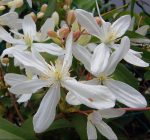 Native to central and southern China to northern Myanmar this fast growing evergreen vine is a member of the buttercup family, Ranunculaceae, that also includes columbine, monkshood, and hellebore. The vine can grow up to 30′ long and climbs by twining. The glossy dark green leaves have three leaflets that are 3-6″ long, leathery and droopy. In early to mid spring clusters of 2-15 fragrant, creamy white flowers appear on the previous year’s growth and are attractive to bees, butterflies and hummingbirds. Each flower is 2-2.5″ across and has 4-8 petal-like parts and numerous long stamens. The fruit is an achene with a long silky plumose tail and provides interest long after the flowers fade. Like other clematis’, C. armandii grows best when the roots are in the shade where they can be cool and stay moist. The vines are vigorous and can quickly cover a structure like a fence so can be useful for providing a screen. The genus name, Clematis, is from the Greek word klematis and was used for various climbing plants. The specific epithet, armandii, honors Father Armand David (1826-1900) a Jesuit missionary and plant collector in China.
Native to central and southern China to northern Myanmar this fast growing evergreen vine is a member of the buttercup family, Ranunculaceae, that also includes columbine, monkshood, and hellebore. The vine can grow up to 30′ long and climbs by twining. The glossy dark green leaves have three leaflets that are 3-6″ long, leathery and droopy. In early to mid spring clusters of 2-15 fragrant, creamy white flowers appear on the previous year’s growth and are attractive to bees, butterflies and hummingbirds. Each flower is 2-2.5″ across and has 4-8 petal-like parts and numerous long stamens. The fruit is an achene with a long silky plumose tail and provides interest long after the flowers fade. Like other clematis’, C. armandii grows best when the roots are in the shade where they can be cool and stay moist. The vines are vigorous and can quickly cover a structure like a fence so can be useful for providing a screen. The genus name, Clematis, is from the Greek word klematis and was used for various climbing plants. The specific epithet, armandii, honors Father Armand David (1826-1900) a Jesuit missionary and plant collector in China.
Type: Evergreen vine
Bloom: Clusters of fragrant creamy white to pink tinted flowers from early to mid spring
Size: 15-30′ H x 10-15′ W
Light: Sun to part shade; roots must be kept cool and moist
Soil: Average, medium moist, well-drained; roots must be kept cool and moist
Hardiness: Zones 7-9
Care: Blooms on old wood so prune after flowering.
Pests and Diseases: Generally healthy but susceptible to damage by aphids, caterpillars, earwig, Clematis slime flux
Propagation: Layering, semi-hardwood or hardwood cuttings
Outstanding Selections:
‘Apple Blossom’ (pink tinged flowers)
‘Hendersonii Rubra’pink flowers)
‘Snowdrift’ (white flowers)
Photo Credit: Wikipedia